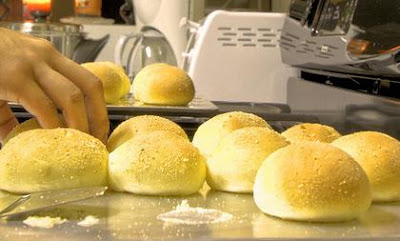To all existing bakery operators, the Food and Nutrition Research Institute (FNRI) has some good news.
In a press conference organized last Monday (14 April 2008), FNRI introduced a new staple that could provide additional source of revenue for the striving pandesal sellers and address the impending increase in the price of imported flour by 5 to 10 percent starting on 15 April 2008.
The increase in imported flour would trigger a rise in the cost of pan de sal up to PhP 2.50 each for the small, 20-gram serving and PhP 3.50 for the regular, 40-gram piece.
The sample provided during the press conference showed that the new pan de sal retains the taste and shape of the original. The only visible difference is the color, hence the name 'yellow' pan de sal.
The new recipe provided by FNRI will allow bakery operators to maintain the price of their pan de sal at PhP 2.00 per small piece and PhP 3.00 per regular piece. This is on the assumption that the current price of the ingredients, like whet and vegetable oil, remain stable.
Salvador Serrano, science research specialist, said that by using squash puree, bakery operators will be able to save on their input cost, but it should not exceed 40 percent of the total ingredient to maintain the desired taste and palatability.
The recipe provides that wheat flour is supplemented with squash flour at 12 percent level. Yeast is added to dough and other traditional ingredients such as shortening, sugar, salt and vanilla. It is the squash which gave the new pan de sal its yellowish color.
Besides helping the bakery operators, FNRI also hopes that the new recipe would help encourage local squash growers to venture into large scale production. Based on the country's climate, FNRI believes that it can provide a good environment for squash farming and cultivation.
The price of squash in some provinces, specifically those in Mindanao, is between PhP 5.00 to PhP 6.00 per kilo, while those in Metro Manila is being sold at PhP 25.00 per kilo.
FNRI Director Mario V. Capanzana reported in the conference that the yellow pan de sal comes fortified with Vitamin A and a 52-gram serving could already provide 24 percent of the Recommended Daily Allowance (RDA) of Vitamin A and 10 percent of the daily energy requirement of a child aged 7 to 9.
Capanzana added that if properly processed, the squash-enriched pan de sal can be mass produced free from pathogenic microorganisms such as E.Coli and salmonella. Under ambient temperature conditions, the 'yellow' pan de sal can have a shelf life of up to three days.
In a press conference organized last Monday (14 April 2008), FNRI introduced a new staple that could provide additional source of revenue for the striving pandesal sellers and address the impending increase in the price of imported flour by 5 to 10 percent starting on 15 April 2008.
The increase in imported flour would trigger a rise in the cost of pan de sal up to PhP 2.50 each for the small, 20-gram serving and PhP 3.50 for the regular, 40-gram piece.
The sample provided during the press conference showed that the new pan de sal retains the taste and shape of the original. The only visible difference is the color, hence the name 'yellow' pan de sal.
The new recipe provided by FNRI will allow bakery operators to maintain the price of their pan de sal at PhP 2.00 per small piece and PhP 3.00 per regular piece. This is on the assumption that the current price of the ingredients, like whet and vegetable oil, remain stable.
Salvador Serrano, science research specialist, said that by using squash puree, bakery operators will be able to save on their input cost, but it should not exceed 40 percent of the total ingredient to maintain the desired taste and palatability.
The recipe provides that wheat flour is supplemented with squash flour at 12 percent level. Yeast is added to dough and other traditional ingredients such as shortening, sugar, salt and vanilla. It is the squash which gave the new pan de sal its yellowish color.
Besides helping the bakery operators, FNRI also hopes that the new recipe would help encourage local squash growers to venture into large scale production. Based on the country's climate, FNRI believes that it can provide a good environment for squash farming and cultivation.
The price of squash in some provinces, specifically those in Mindanao, is between PhP 5.00 to PhP 6.00 per kilo, while those in Metro Manila is being sold at PhP 25.00 per kilo.
FNRI Director Mario V. Capanzana reported in the conference that the yellow pan de sal comes fortified with Vitamin A and a 52-gram serving could already provide 24 percent of the Recommended Daily Allowance (RDA) of Vitamin A and 10 percent of the daily energy requirement of a child aged 7 to 9.
Capanzana added that if properly processed, the squash-enriched pan de sal can be mass produced free from pathogenic microorganisms such as E.Coli and salmonella. Under ambient temperature conditions, the 'yellow' pan de sal can have a shelf life of up to three days.


















0 comments
Post a Comment